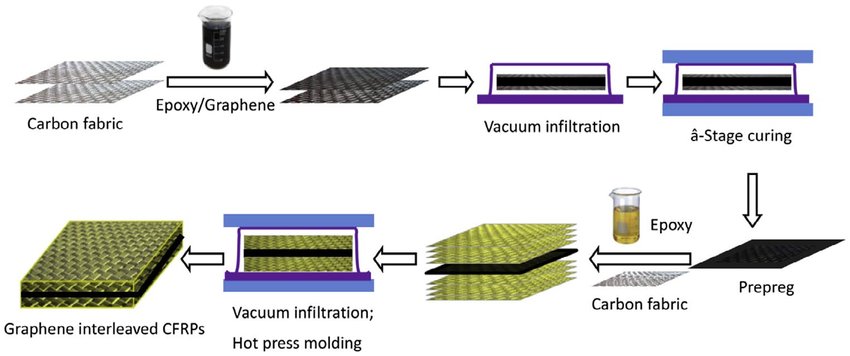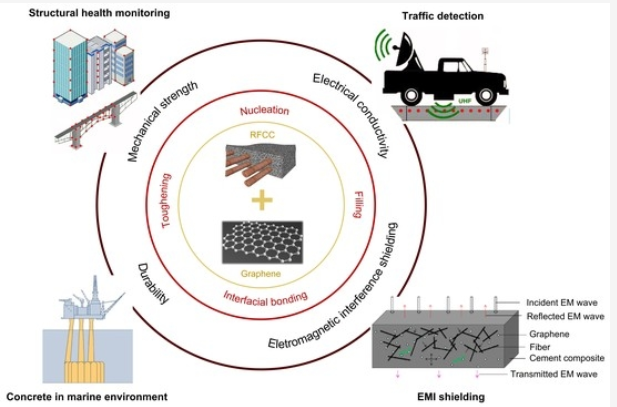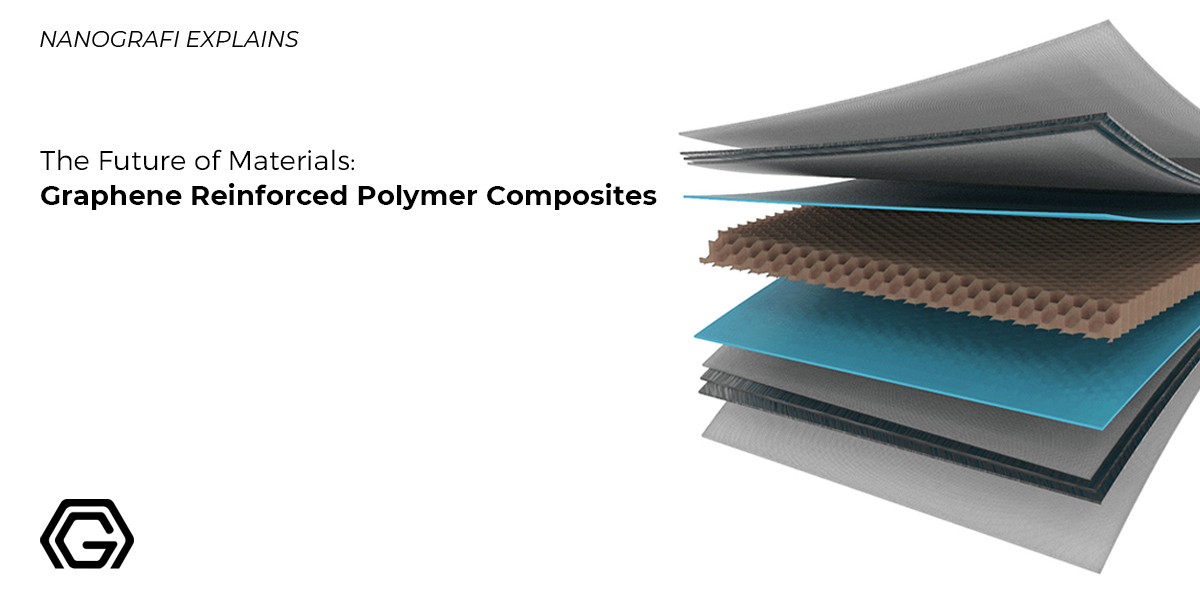The Future of Materials: Graphene Reinforced Polymer Composites - Nanogafi
Graphene-reinforced polymer composites are gaining attention due to their exceptional properties and wide applications. Graphene, a two-dimensional carbon material, enhances mechanical strength, electrical conductivity, thermal management, and barrier properties.
When combined with polymer matrices, graphene greatly enhances the performance of composite materials. Graphene-reinforced polymer composites find applications in various industries, including automotive, aerospace, electronics, energy storage, and biomedical sectors. This blog post highlights the importance and potential of graphene-reinforced polymer composites, exploring their wide-ranging applications and discussing the impact they are poised to make in the future. At Nanografi, we aim to provide you superior quality graphene, considering the application areas, future performance expectations, and advantages of graphene-reinforced polymer composites.
Introduction
Graphene-reinforced polymer composites have garnered significant attention due to their remarkable properties and potential applications in various industries. Graphene, a two-dimensional carbon allotrope, possesses exceptional mechanical strength, electrical conductivity, heat dissipation capability, and barrier properties. When incorporated into polymer matrices, graphene can significantly enhance the mechanical, electirical, thermal, and barrier characteristics of the composites. This introduction provides an overview of the fundamentals of graphene and polymer composites, emphasizing the importance of graphene reinforcement and the synergistic effects it offers.
Furthermore, it explores the fabrication techniques utilized for creating graphene-reinforced composites and highlights the characterization methods employed to assess their performance. The numerous advantages and applications of graphene-reinforced polymer composites are also addressed, spanning across industries such as automotive, aerospace, electronics , energy storage, and medicine. While challenges related to scalability, cost, and long-term stability persist, ongoing research and development endeavors aim to overcome these hurdles and unlock the full potential of graphene-reinforced polymer composites in the future.
Graphene and Polymer Composites: Fundamentals
Graphene and its Properties
The two-dimensional allotrope of carbon known as graphene is made up of a single layer of carbon atoms organized in a hexagonal lattice. It is frequently referred to as a "wonder material" because of its extraordinary qualities and limitless potential for a wide range of uses. Here is a summary of graphene's main attributes:
Structure: One atom's worth of graphene is all that separates it from being a flat sheet. Strong covalent connections between the carbon atoms in the sheet form a lattice that resembles a honeycomb.
Mechanical Strength: Graphene is exceptionally stiff and strong mechanically. It is one of the strongest materials yet discovered, with a tensile strength of roughly 130 gigapascals (GPa). Additionally, due to its great degree of flexibility, it may be stretched without cracking.
Electrical Conductivity: Graphene is a super electrical conductor. It has a high electron mobility, which reduces the resistance faced by electrons as they flow through the structure. Because of this characteristic, graphene may be used in electronics components including transistors, sensors, and conductive coatings.
Heat Conductivity: The heat conductivity of graphene is quite good. Strong carbon-carbon bonding and significant phonon mobility within its structure enable efficient heat transmission. Graphene is advantageous for applications in thermal management, such as heat sinks or thermal interface materials, because of its feature.
Basics of Polymer Composites
A polymer matrix and a reinforcing material are combined to form polymer composites, which can have two or more components. To improve the mechanical, thermal, or electrical characteristics of the polymer matrix, the reinforcing material—often in the form of fibers, particles, or flakes—is disseminated inside it. Some of the the fundamentals of polymer composites are as follows:
Polymer Matrix: The continuous phase of the composite that gives the material its structure and cohesion is the polymer matrix. It could be a polymer that is thermoplastic or thermosetting. While thermosetting polymers, like epoxy or polyester, suffer irreversible curing when heated, thermoplastic polymers, like polyethylene or polystyrene, may repeatedly melt and solidify.
Reinforcing Material: To enhance particular qualities of the composite, reinforcing material is included into the polymer matrix. It can take the shape of flakes (like graphene or mica) or particles (like silica or clay). It can also take the form of fibers (like carbon, glass, or aramid). Increased strength, stiffness, toughness, or other desirable attributes may result from the use of the reinforcing material.
Dispersion: To achieve a homogeneous dispersion, the reinforcing material is spread throughout the polymer matrix. Techniques including impregnation, melt mixing, solution mixing, or in situ polymerization can be used to accomplish this.
Applications: Polymer composites are used in a variety of fields, including electronics, aircraft, automotive, building, and more. They are employed in the production of lightweight yet durable components, such as those found in sporting goods, vehicle panels, wind turbine blades, and aviation parts. Additionally, they have benefits in terms of design freedom, corrosion resistance, and custom material qualities.
Importance and Advantages of Graphene Reinforcement
A major advancement in material science, the reinforcing of polymers with graphene offers a number of substantial benefits. The following are some of the main benefits and significance of graphene reinforcement:
Improved Mechanical Properties: The high tensile strength, rigidity, and toughness of graphene contribute significantly to enhancing the mechanical strength, modulus, and toughness of polymer composites. These materials can be valuable for reinforcing military equipment and structures. For instance, graphene-reinforced polymer materials can enhance the strength of ballistic protection plates used in armor systems or improve the combination of lightweight and durability in composite materials used in military vehicles.
Superior Electrical Conductivity: Because graphene is such a good electrical conductor, the composites that are produced have a high electrical conductivity. Applications for this trait include electronics, sensors, electromagnetic interference shielding, and energy storage technologies. Polymers may be made electrically conductive using graphene reinforcement without losing other desired features.
Thermal Conductivity and Heat Dissipation: Graphene effectively dissipates heat due to its excellent thermal conductivity. Graphene increases the thermal conductivity of polymers and makes it possible for improved heat dissipation. Applications needing efficient thermal management, such electrical equipment or heat sinks, can benefit from this characteristic.
Improved Barrier Properties: Graphene reinforcement can improve the polymer's ability to act as a gas and liquid barrier. A convoluted channel created by the peculiar structure of graphene sheets or particles prevents chemicals from permeating through the composite material. Applications for this trait include packaging, protective coatings, and barrier films.
Lightweight: Graphene is a very light substance in and of itself. It aids in maintaining or even lowering the total weight of the material while also improving its mechanical qualities when employed as a reinforcement in polymer composites. This is particularly significant in sectors like aircraft and automotive, where weight reduction is essential for enhancing performance and fuel economy.
Flexibility and Processability: Reinforcement made of graphene may be added to polymers in a variety of ways, such as sheets, flakes, nanoparticles, or functionalized derivatives. Due to its adaptability, graphene may be incorporated into a variety of polymer matrices, allowing for flexibility in the production process. Extrusion, injection molding, and 3D printing are common methods for processing polymers reinforced with graphene.
Benefits for the environment: Graphene reinforcement might help with environmental initiatives. Enhancing the performance of polymer materials may help cut down on material usage and increase product lifespan, resulting in less waste production and resource consumption. Additionally, compared to other reinforcing materials, graphene itself may be produced from sustainable carbon sources, thus providing environmental benefits.
To discover about all the uses and applications of graphene, you can read our most popular blog.
Synergistic Effects of Graphene-Polymer Combination
In composite materials, the addition of graphene to polymers can have synergistic effects that greatly improve the composite's qualities over the sum of its parts. The following are some significant synergistic effects in graphene-polymer combinations:
- Electrical Conductivity
- Mechanical Reinforcement
- Temperature Conduction
- Barrier Features
- Enhanced dispersion
- Multifunctionality of the interface
These synergistic effects make graphene-polymer composites very appealing for a variety of applications, from electronics and automotive parts to packaging, energy storage, and aerospace and automobile components. The graphene-polymer combination will be further optimized via ongoing research and development, and new uses for these sophisticated composite materials will be investigated.
Fabrication Techniques for Graphene Reinforced Polymer Composites
Graphene reinforced polymer composites are materials that increase the mechanical, thermal, and electrical characteristics of the composite by fusing graphene, a two-dimensional carbon allotrope, with a polymer matrix. Graphene reinforced polymer composites are made using a variety of manufacturing processes, including:
- Solution Mixing/Blending
A homogenous combination of graphene and a polymer solution may be created. The polymer solution can be combined with graphene that has been dispersed in a solvent. In order to facilitate the dispersion of graphene in the solvent, a variety of procedures including sonication and high-speed stirring are employed. To create the composite material, the resultant mixture can either be cast or evaporated using a solvent.
- Melt Processing (a)
Graphene is incorporated into a molten polymer during the melting process. Typically, twin-screw extrusion or injection molding processes are used to incorporate the graphene into the polymer melt. To create the graphene reinforced polymer composite, the molten mixture is subsequently cooled and solidified. Most thermoplastic polymers are processed using a melt.
- In Situ Polymerization (b)
In this method, graphene is introduced to a monomer solution, and polymerization is started in its presence to create the polymer matrix. During the polymerization process, graphene serves as a template and is incorporated into the polymer matrix. This technique improves control over graphene dispersion but calls for certain monomers and reaction circumstances.
- Electrospinning
Polymer fibers with widths in the nano- to micrometer range are created using the electrospinning process. To create graphene reinforced polymer nanofibers, graphene can be added to the polymer solution used for electrospinning. The alignment of graphene within the fibers is facilitated by the electrospinning process, improving the mechanical characteristics.
- Layer-by-Layer Assembly
In order to build a stacked structure, his method alternately deposits polymer layers and graphene sheets. Utilizing techniques like spray coating, dip coating, or spin coating, each layer is applied. The exact control of the graphene composition and layout inside the composite is made possible by the layer-by-layer construction.

Figure 1. Fabrication of graphene interleaved carbon fiber/epoxy composites.
Graphene Reinforced Polymer Composites
- 3D Printing
The manufacture of graphene reinforced polymer composites has generated great interest in 3D printing, commonly referred to as additive manufacturing. It provides special benefits including design adaptability, intricate geometries, and the capacity to produce customized structures.
It is significant to remember that the selection of the manufacturing method is influenced by a number of variables, including the required qualities of the composite, the chosen polymer matrix, and the planned application. Additionally, functionalized graphene or surface-modified graphene can be used to increase the dispersion and interfacial interactions with the polymer, improving the performance of composites.
Characterization of Graphene Reinforced Polymer Composites
Mechanical Testing: Strength, Toughness, and Stiffness
When evaluating graphene reinforced polymer composites mechanically, many testing techniques are used to gauge the materials' strength, stiffness, and toughness. Impact testing examines the composite's capacity to absorb energy during abrupt hits, flexural testing gauges the composite's behavior under bending pressures, and tensile testing gauges the composite's response to stretching forces. These studies offer important insights into the improvements in mechanical characteristics brought on by the addition of graphene to the composite material.
Electrical and Thermal Conductivity Analysis
The capacity of graphene reinforced polymer composites to conduct electricity and heat is evaluated using electrical and thermal conductivity studies. Lower resistance indicates increased electrical conductivity due to graphene, according to an electrical conductivity analysis that analyzes the resistance or sheet resistance of the composite. Higher thermal conductivity indicates improved heat dissipation capabilities due to graphene, according to an examination of the composite's capacity to conduct heat. These evaluations assist in determining if the composites are suitable for uses requiring effective electrical conduction or heat dissipation.
Morphological and Structural Characterization
Analyzing the physical makeup, configuration, and distribution of graphene inside the composite allows for morphological and structural evaluation of graphene reinforced polymer composites. Morphological characterisation includes methods like scanning electron microscopy (SEM) and transmission electron microscopy (TEM) to analyze the surface and interior structure. When doing structural characterisation, methods including X-ray diffraction (XRD) and Fourier-transform infrared spectroscopy (FTIR) are used to examine the crystal structure, orientation, and interfacial interactions. These characterizations help with the composites' optimization and application-specific personalization by offering useful insights into their morphology, distribution, and structural characteristics.
Chemical and Physical Properties Evaluation
physical and chemical characteristics It entails evaluating the chemical make-up, thermal stability, mechanical characteristics, and electrical conductivity of graphene reinforced polymer composites. For analyzing chemical composition, methods like FTIR and Raman spectroscopy are utilized, whereas TGA and DSC are used to assess thermal stability. The mechanical characteristics of the composite are evaluated using impact and tensile testing methods. The composite's capacity to conduct electricity is measured by electrical conductivity. These analyses offer insightful data on the chemical behavior, thermal performance, mechanical strength, and electrical conductivity of the composite, allowing researchers to comprehend and enhance its characteristics for particular applications.
Performance Enhancements with Graphene Reinforcement
Mechanical Performance Improvement
The mechanical performance of polymer composites is enhanced by graphene reinforcement. It improves weight reduction, stiffness, toughness, and fatigue resistance. Composites reinforced with graphene have better load-bearing capacity, stiffness, impact resistance, durability, and weight potential. They are sought for high-performance applications in numerous sectors as a result of these improvements.
Enhanced Electrical and Thermal Conductivity
In polymer composites, graphene reinforcement improves thermal and electrical conductivity. It enhances the composite's electrical conductivity, making it acceptable for uses that call for effective electrical conduction. Additionally, the composite's enhanced capacity for heat conduction makes graphene reinforcement useful for applications needing efficient heat dissipation. The graphene loading and distribution may be adjusted to alter the conductivity qualities. Overall, industries that demand improved electrical and thermal conductivity can benefit from the multifunctionality and extended application options offered by graphene-reinforced composites.
Barrier Properties and Gas Permeability
Polymer composites with graphene reinforcement have better barrier qualities and have less gas penetration. The addition of graphene sheets improves the composite's capacity to function as a barrier material by forming a barrier that prevents the flow of gases and liquids. Applications that call for low gas permeability, such packaging, coatings, and membranes, can benefit from this characteristic. By altering the loading and distribution of graphene, the gas barrier performance may be customized. Overall, the increased barrier qualities and decreased gas permeability of graphene-reinforced composites make them appropriate for a variety of applications.
Flame Retardancy and Fire Resistance
Polymer composites with graphene reinforcement have improved fire resistance and flame retardancy. It serves as a barrier against heat and oxygen, lessens flammability, and inhibits the spread of flames. Composites bonded with graphene have better fire resistance, produce less smoke, and may even self-extinguish. These features help people adhere to fire laws and improve fire safety.
Applications of Graphene Reinforced Polymer Composites
- Automotive and Aerospace Industry
Graphene-reinforced polymer composites in the automobile sector offer lightweighting, increased strength and stiffness, greater impact resistance, and electrical conductivity. They are employed in vehicle electronics, EV battery systems, structural components, and noise and vibration dampening.
Graphene-reinforced polymer composites in the aerospace sector offer lightweight construction, high-performance components, enhanced thermal management, electrical conductivity, and greater safety. They are used in aerospace electronics, thermal barriers, aircraft components, and structural integrity augmentation.
- Electronics and Energy Storage
Composites reinforced with graphene are used in electrical and electronic equipment. Printed circuit boards, sensors, conductive coatings, and electromagnetic shielding may all make use of them because of their superior electrical conductivity and mechanical qualities.
Lithium-ion batteries and supercapacitors are two examples of energy storage systems that use graphene-reinforced composites. Their ability for energy storage, temperature control, and electrical conductivity are all improved by the use of graphene.
- Biomedical and Healthcare Applications
Medical uses for graphene-reinforced composites include tissue engineering, medication delivery devices, and orthopedic implants. They have qualities that are advantageous for medical devices and regenerative medicine, including as biocompatibility, mechanical strength, and electrical conductivity.
- Construction and Infrastructure
Composites reinforced with graphene may find use in the building sector. They may be used to reinforce concrete constructions, increasing their durability and mechanical strength. They can also be used to create strong, lightweight construction materials.

Figure 2. Applications of graphene reinforced polymer composites.
Challenges and Future Outlook
Although graphene-reinforced polymer composites have a lot of potential, a number of issues need to be resolved before they can be widely used. Here are some of the main issues and the prospects for the future:
Scalability and Cost Considerations
The cost-effectiveness of graphene-reinforced composites is currently impacted by the high cost of graphene manufacture. To make these composites more economically viable, improvements in large-scale production techniques and cost-cutting techniques are required.
It is still difficult to disperse and orient graphene in polymer matrices uniformly on a large scale. Commercialization depends on scaling up the production process while keeping constant quality and characteristics
Durability and Long-Term Stability
It's crucial to comprehend the long-term durability and aging behavior of graphene-reinforced composites for their consistent performance throughout time. To evaluate their stability, processes for deterioration, and resistance to environmental influences, more study is required.
Future Prospects
Despite the difficulties, graphene-reinforced polymer composites have a bright future ahead of them. These issues are being aggressively addressed by academics and business leaders in order to realize the full potential of these composites. Here are some crucial areas for future growth:
Improved Manufacturing Techniques: Graphene-reinforced composites' production efficiency and scalability can be increased because to improvements in manufacturing techniques including additive manufacturing and continuous manufacturing procedures.
Advancing Electronic Properties: Graphene-reinforced composite characteristics are being further researched in order to be optimized for certain applications. This entails researching hybrid combinations with various reinforcing materials as well as refining the loading, dispersion, and alignment of graphene.
Composites with multiple functions: By combining graphene with other substances like nanoparticles or fibers, composites with multiple functions can be created that have improved mechanical strength, electrical conductivity, thermal stability, and self-healing abilities.
Sustainable and environmentally friendly solutions: Graphene and composites reinforced with it are being produced using environmentally friendly and sustainable methods. This entails looking into sustainable graphene sources and employing bio-based or recycled polymers as matrix components.
Real-World Applications: Graphene-reinforced composites will become more widely used in the future in a variety of fields and applications, including automotive, aerospace, electronics, energy storage, and healthcare. These composites might change current technology and make it possible to create brand-new, cutting-edge solutions.
Conclusion
In conclusion, graphene-reinforced polymer composites have several advantages and prospective uses in a variety of fields. They have outstanding barrier characteristics, flame retardancy, electrical and thermal conductivity, and mechanical qualities. Although there are still issues with cost, scalability, processing methods, and standardization, the prospects for graphene-reinforced composites in the future are optimistic.
Future breakthroughs are being driven by improvements in production methods, specialized property optimization, environmental initiatives, and the incorporation of graphene with other materials. The automotive, aerospace, electronics, energy storage, construction, and medical sectors, among others, might all be completely transformed by these composites.
Graphene-reinforced polymer composites are anticipated to significantly improve performance, efficiency, and safety in a variety of applications with continued study and technical development. With their distinctive qualities and adaptability, they provide fascinating opportunities for innovation and have the power to influence the direction of whole sectors.
Leveraging cutting-edge technologies and superior materials, Nanografi redefines your ventures and catapults your business to novel dimensions.
References
60 Uses and Applications of Graphene – Nanografi - Nanografi Nano Technology. (n.d.). Retrieved March 20, 2024, from https://nanografi.com/blog/60-uses-and-applications-of-graphene-nanografi-/
Advantages of 3D Printing in Nanotechnology - Nanografi Nano Technology. (n.d.). Retrieved March 20, 2024, from https://nanografi.com/blog/advantages-of-3d-printing-in-nanotechnology-/
Applications of Graphene in Medicine - Nanografi Nano Technology. (n.d.). Retrieved March 20, 2024, from https://nanografi.com/blog/applications-of-graphene-in-medicine/
Applications of Graphene in Military - Nanografi Nano Technology. (n.d.). Retrieved March 20, 2024, from https://nanografi.com/blog/applications-of-graphene-in-military/
Ceretti, E., Ginestra, P. S., Ghazinejad, M., Fiorentino, A., & Madou, M. (2017). Electrospinning and characterization of polymer–graphene powder scaffolds. CIRP Annals - Manufacturing Technology, 66(1), 233–236. https://doi.org/10.1016/J.CIRP.2017.04.122
Explained: Graphene - Nanografi Nano Technology. (n.d.). Retrieved March 20, 2024, from https://nanografi.com/blog/explained-graphene/
Graphene Nanoplatelets Electrical Properties & Applications - Nanografi - Nanografi Nano Technology. (n.d.). Retrieved March 20, 2024, from https://nanografi.com/blog/graphene-nanoplatelets-electrical-properties-applications-nanografi/
Istrate, O. M., Paton, K. R., Khan, U., O’Neill, A., Bell, A. P., & Coleman, J. N. (2014). Reinforcement in melt-processed polymer-graphene composites at extremely low graphene loading level. Carbon, 78, 243–249. https://doi.org/10.1016/J.CARBON.2014.06.077
Lighter than Air: Aero-Graphenes or Graphene Aerogels - Nanografi Nano Technology. (n.d.). Retrieved March 20, 2024, from https://nanografi.com/blog/lighter-than-air-aerographenes-or-graphene-aerogels/
Nanoparticles Dispersions - Nanografi Nano Technology. (n.d.). Retrieved March 20, 2024, from https://nanografi.com/blog/nanoparticles-dispersions/
Polyethylene - Wikipedia. (n.d.). Retrieved March 20, 2024, from https://en.wikipedia.org/wiki/Polyethylene
Use of Graphene in Electronics - Nanografi Nano Technology. (n.d.). Retrieved March 20, 2024, from https://nanografi.com/blog/use-of-graphene-in-electronics/
Recent Posts
-
Advanced Materials for Unmanned Aerial Vehicle (UAV) Protection Against Laser
Consider a UAV on a critical mission, rendered inoperative by a sudden laser attack. With the increa …26th Jul 2024 -
Simulation and Modeling of Material Properties
Our world is composed of a dazzling array of materials, each with its own unique properties that dic …19th Jul 2024 -
Advanced Coatings for Superior Corrosion and Wear Resistance
Corrosion and wear pose significant challenges across various industries, leading to substantial eco …12th Jul 2024







